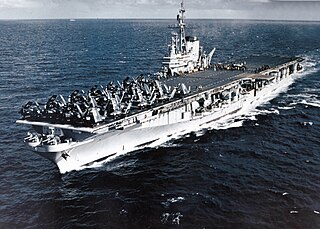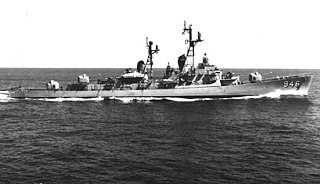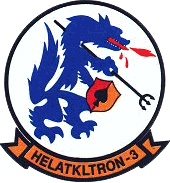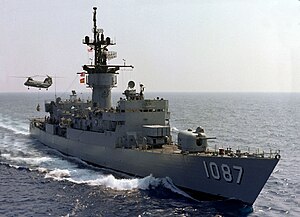
Graham Anderson Martin was an American diplomat. He was the ambassador to Thailand and as U.S. representative to SEATO from 1963 to 1967, ambassador to Italy from 1969 to 1973 and the last United States Ambassador to South Vietnam from 1973 until his evacuation during the Fall of Saigon in 1975.

USS Duluth (LPD-6), an Austin-class amphibious transport dock, is the second ship of the United States Navy named for the city in Minnesota.

USS Dubuque (LPD-8) is an Austin-class amphibious transport dock of the United States Navy.

USS Midway (CVB/CVA/CV-41) is an aircraft carrier, formerly of the United States Navy, the lead ship of her class. Commissioned 8 days after the end of World War II, Midway was the largest warship in the world until 1955, as well as the first U.S. aircraft carrier too big to transit the Panama Canal. She operated for 47 years, during which time she saw action in the Vietnam War and served as the Persian Gulf flagship in 1991's Operation Desert Storm. Decommissioned in 1992, she is now a museum ship at the USS Midway Museum, in San Diego, California, and is the only remaining inactive U.S. aircraft carrier that is not an Essex-class aircraft carrier.

USS Edson (DD-946) is a Forrest Sherman-class destroyer, formerly of the United States Navy, built by Bath Iron Works in Maine in 1958. Her home port was Long Beach, California and she initially served in the Western Pacific/Far East, operating particularly in the Taiwan Strait and off the coast of Vietnam. Her exceptionally meritorious service in 1964 in the Gulf of Tonkin was recognized with the first of three Navy Unit Commendations. During the following years she was shelled by North Vietnamese land forces, and apparently received friendly fire from the US Air Force.

The second USS Henry W. Tucker (DD-875) was a Gearing-class destroyer of the United States Navy.

USS Okinawa (LPH–3) was the second Iwo Jima-class amphibious assault ship of the United States Navy. She was the second Navy ship assigned the name "Okinawa", in honor of the World War II Battle of Okinawa.

USS Blue Ridge (LCC-19) is the lead ship of the two Blue Ridge-class amphibious command ships of the United States Navy, and is the flagship of the Seventh Fleet. Her primary role is to provide command, control, communications, computers, and intelligence (C4I) support to the commander and staff of the United States Seventh Fleet. She is currently forward-deployed to U.S. Navy Fleet Activities, Yokosuka in Japan, and is the third Navy ship named after the Blue Ridge Mountains, a range of mountains in the Appalachian Mountains of the eastern United States. Blue Ridge is the oldest deployed warship of the U.S. Navy, following the decommissioning of USS Denver. Blue Ridge, as the U.S. Navy's active commissioned ship having the longest total period as active, flies the First Navy Jack instead of the jack of the United States. Blue Ridge is expected to remain in service until 2039.

The fall of Saigon, was the capture of Saigon, the capital of South Vietnam, by North Vietnam on 30 April 1975. The event marked the end of the Vietnam War and the collapse of the South Vietnamese state, leading to a transition period and the formal reunification of Vietnam into the Socialist Republic of Vietnam under communist rule on July 2 1976.

Operation Frequent Wind was the final phase in the evacuation of American civilians and "at-risk" Vietnamese from Saigon, South Vietnam, before the takeover of the city by the North Vietnamese People's Army of Vietnam (PAVN) in the Fall of Saigon. It was carried out on 29–30 April 1975, during the last days of the Vietnam War. More than 7,000 people were evacuated by helicopter from various points in Saigon. The airlift resulted in a number of enduring images.
Đỗ Kiếm, writing as Kiem Do is a former officer of the Republic of Vietnam Navy, who was serving as Deputy Chief of Staff (Operations) when Saigon fell in 1975. He secretly organised the evacuation of over 30,000 refugees aboard 32 naval ships. Kiem's efforts were ultimately successful, preventing those 32 vessels and everyone aboard from falling into the hands of North Vietnamese forces.

USS Sterett (DLG/CG-31) was a Belknap-class destroyer leader / cruiser. She was the third ship to be named for Master Commandant Andrew Sterett (1778–1807), who served during the Quasi-War with France and the Barbary Wars. She was launched as DLG-31, a frigate, and reclassified a cruiser (CG) on 30 June 1975.

USS Meyerkord (FF-1058) was a Knox-class frigate in service with the United States Navy from 1969 to 1991. She was scrapped in 2001.

USS Camp (DE-251) was an Edsall-class destroyer escort built for the U.S. Navy during World War II. She served in the Atlantic Ocean the Pacific Ocean and provided destroyer escort protection against submarine and air attack for Navy vessels and convoys.

USS LST-821, renamed USS Harnett County (LST-821/AGP-281), is an LST-542-class tank landing ship built for the United States Navy during World War II. She was named for Harnett County, North Carolina and was the only U.S. Naval vessel to bear the name. She served the United States Navy in World War II and the Vietnam War. She was transferred to South Vietnam's Republic of Vietnam Navy, which named her RVNS My Tho (HQ-800).

USS Bering Strait (AVP-34) was a United States Navy Barnegat-class small seaplane tender in commission from 1944 to 1946. She tended seaplanes during World War II in the Pacific in combat areas and earned three battle stars by war's end.

USS Cook Inlet (AVP-36) was a United States Navy Barnegat-class small seaplane tender in commission from 1944 to 1946. She tended seaplanes during World War II in the Pacific and earned one battle star for her service. After the war, she was transferred to the United States Coast Guard, and was in commission as the Coast Guard cutter USCGC Cook Inlet (WAVP-384), later WHEC-384, from 1949 to 1971. She saw service in the Vietnam War during her Coast Guard career, receiving two campaign stars for her operations during the conflict. Transferred to South Vietnam in 1971, she operated as the Republic of Vietnam Navy frigate RVNS Trần Quốc Toản (HQ-06) until South Vietnam's collapse in April 1975 at the end of the Vietnam War. She fled to the Philippines and in 1976 was transferred to the Philippine Navy, which never commissioned her, instead using her as a source of spare parts for her sister ships, the Andrés Bonifacio-class frigates, before discarding her in 1982.
The BRP Francisco Dagohoy (PF-10) was an Andrés Bonifacio-class frigate of the Philippine Navy that served from 1979 to 1985. She was one of six ex-United States Navy Barnegat-class small seaplane tenders and ex-United States Coast Guard Casco-class high endurance cutters received from the United States after the Vietnam War, two of which were cannibalized for spare parts without entering service. She and her other three sister ships were the largest Philippine Navy ships of their time.

USS Castle Rock (AVP-35) was a United States Navy Barnegat-class small seaplane tender in commission from 1944 to 1946 which saw service in the late months of World War II. After the war, she was in commission in the United States Coast Guard as the Coast Guard cutter USCGC Castle Rock (WAVP-383), later WHEC-383, from 1948 to 1971, seeing service in the Vietnam War during her Coast Guard career. Transferred to South Vietnam in 1971, she served in the Republic of Vietnam Navy as the frigate RVNS Trần Bình Trọng (HQ-05) and fought in the Battle of the Paracel Islands in 1974. When South Vietnam collapsed at the end of the Vietnam War in 1975, Trần Bình Trọng fled to the Philippines, where she served in the Philippine Navy from 1979 to 1985 as the frigate RPSFrancisco Dagohoy (PF-10).

HA(L)-3,, nicknamed the "Seawolves", was an all-volunteer squadron in the US Navy formed in support of Naval Special Warfare operations and Mobile Riverine Forces during the Vietnam War.


















